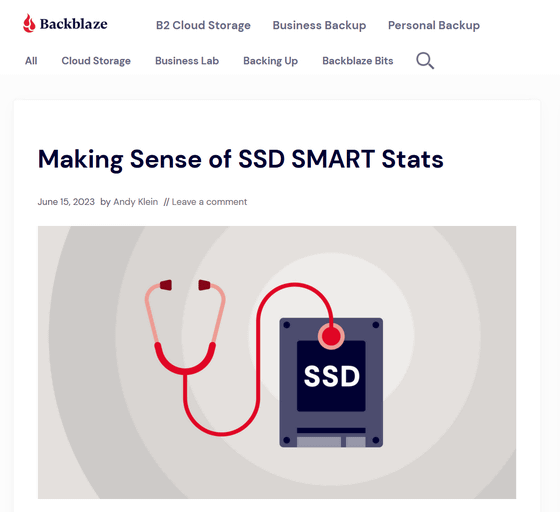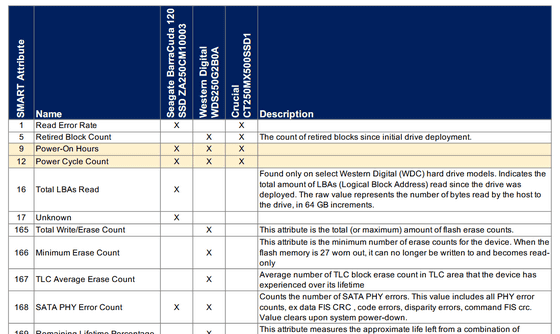What items are there in the SMART information to know the lifespan of the SSD?

In recent years, with the advent of large-capacity SSD drives, the main storage of PCs has shifted from HDDs to SSDs. SSDs are more resistant to physical shocks than HDDs and read and write faster, but SSDs also have a lifespan, and the longer they are used, the more they wear out. Backblaze, a cloud storage company, explains Self Monitoring, Analysis, and Reporting Technology (SMART) , which is information for monitoring the state of such SSDs.
Making Sense of SSD SMART Stats
https://www.backblaze.com/blog/making-sense-of-ssd-smart-stats/

Whether SSDs can be used as offline data storage has long been debated, but according to Backblaze, ``If the SSD is new, you can safely store data for about a year without a power supply.'' Thing. However, as the drive wears out, the retention period decreases. In other words, when storing data for a long period of time, it is necessary to constantly check the lifespan and degree of wear of the SSD.
SMART, which self-diagnoses and quantifies the SSD status in real time, is useful in such cases for the purpose of early detection and failure prediction. Backblaze always runs more than 10 types of SSD, gets SMART information from each model every day, and checks the degree of wear of SSD. Backblaze is an SSD with a storage capacity of 250 GB from three companies, Seagate, Western Digital, and Crucial, and summarizes the SMART information necessary to estimate the lifespan of the SSD.

There are 255 items in SMART, and the three SSDs compared this time can display 44 of them. However, the items and contents to be shown are different among manufacturers and are not standardized. Also, it seems that there are cases where the items are different even though the same things are checked. Backblaze says, ``Different manufacturers are basically checking different items for the same thing. This highlights SMART's flaws. It depends on the whims, patience and tenacity of the manufacturer, whether they check it properly.'
Of the 44 SMART information items displayed for each storage, only the following five are common.
・SMART 9: Power-On Hours
Total time in power-on state.
・SMART 12: Power Cycle Count
The number of times the SSD has been powered off and then on again. This is cumulative and recorded over the lifetime of the SSD.
・SMART 194: Temperature
SSD internal temperature.
・SMART 173: SSD Wear Leveling
Maximum number of erasures per block
・SMART 174: Unexpected Power Loss Count
Number of unexpected shutdowns. This is cumulative and recorded over the lifetime of the SSD.

Also, although the SMART information read by the manufacturer differs, the following items are particularly useful for understanding the lifespan of the SSD. As you can see, the contents are almost the same, but the SMART item numbers and names are different depending on the manufacturer. A page is the smallest unit that can be read and written in the NAND flash memory that makes up an SSD, and a collection of pages is called a block.
・SMART 169: Remaining Lifetime Percentage (Western Digital)
The NAND flash memory that makes up an SSD must first erase existing data in order to write new data. There is a limit to the number of processes called 'P/E (program/erase) cycles' that erase data in order to write this data. Also, when an SSD has a bad block that cannot be written to, an unused spare block is allocated, and the remaining number of this spare block is also checked. This item measures the remaining life of the SSD from P/E cycles and unused spare blocks. A brand new SSD will report a value of '100' and decrease to '0' with use.
・SMART 202: Percentage of Lifetime Used (Crucial)
Shows how far the SSD has reached in its pre-specified lifespan. It will show '0' for a brand new SSD and '100' if it reaches the specified lifespan.
・SMART 231: Life Left (Seagate)
The number of P/E cycles and spare blocks indicates the approximate remaining life of the SSD. For a brand new SSD, the normalized value is '100' and decreases from there to '10' indicating the need for replacement. A value of '0' means the drive is operating in read-only mode.

Logical Block Addressing (LBA) write and read counts are just blocks that have been written or read. Each time a block is written or read, the following items are incremented by one:
・SMART 241: LBAs Written (Seagate・Western Digital)
Total number of LBA writes.
・SMART 242: LBAs Read (Seagate・Western Digital)
Total number of LBA reads.
・SMART 246: Cumulative Host Sectors Written (Crucial)
LBA writes performed by computer demand.
And when Bakcblaze operates a lot of SSDs, the following SMART items are considered to be interesting in knowing the lifespan of SSDs.
・SMART 230: Drive Life Protection Status (Western Digital)
An item that indicates whether the SSD usage trajectory is above the expected lifespan curve. In other words, it is an item that shows how much consumption is actually progressing against the 'ideal consumption speed of SSD' assumed by the manufacturer.
・SMART 210: RAIN Successful Recovery Page Count (Crucial)
' RAIN ' is a technology developed by Crucial that provides data redundancy in a manner similar to RAID . However, this redundancy must consume some additional capacity. This item shows the number of pages set aside for RAIN.
・SMART 232: Endurance Remaining (Seagate・Western Digital)
Percentage of erases actually completed out of the maximum number of erases set on the SSD. It is similar to the SMART 231 mentioned above, but it does not take spare blocks into account.
・SMART 233: Media Wearout Indicator (Seagate・Western Digital)
The total number of data erasures actually performed on the SSD.
・SMART 171: SSD Program Fail Count (Western Digital ・ Crucial)
The number of failed page writes accumulated since the SSD has been running.
・SMART 172: SSD Erase Count Fail (Western Digital Crucial)
The number of page erase failures accumulated since the SSD has been in operation.
Backblaze also states that he is not sure what the following items are for or what they are showing.
・SMART 16: Total LBAs Read (Seagate)
The item name is 'Total number of LBA reads', which is the same as SMART 242 mentioned above. Backblaze speculates that you probably misspelled the name of the SMART item.
・SMART 17: Unknown (Seagate)
I only know that Seagate SSD SMART reports this item, and I don't know what it is.
・SMART 196: Reallocation Event Count (Crucial)
・SMART 197: Current Pending Sector Count (Crucial)
・SMART 198: Uncorrectable Sector Count (Crucial)
Backblaze says that it makes no sense for SSDs to report this item because it is related to the magnetic disk of the HDD.
・SMART 206: Flying Height (Crucial)
'Flying Height' is the flying height of the magnetic head used in HDDs relative to the disk. Of course, SSDs don't have magnetic heads, so there's no point in reporting this item.

Backblaze said, ``It's great that SSD manufacturers have recorded relevant information about the condition and health of the drive model in SMART information.Many manufacturers also monitor these SMART information and provide user feedback. Providing software is also wonderful.' However, he pointed out that the efficiency of system management at the site has decreased because the items to be checked are disjointed for each manufacturer. 'Instead of making SSD SMART proprietary, it may be time to consider fully standardizing SMART item names and content so that all SSD manufacturers comply,' he said. rice field.
You can see the table of SMART information shown by Seagate, Western Digital and Crucial SSD summarized by Backblaze from the following.
SMART Values in Use - various drives.xlsx - 2 - SSD+SMART+Stats+Comparison+Table.pdf
(PDF file) https://f001.backblazeb2.com/file/Backblaze_Blog/SSD+SMART+Stats+Comparison+Table.pdf

Related Posts:
in Hardware, Posted by log1i_yk







